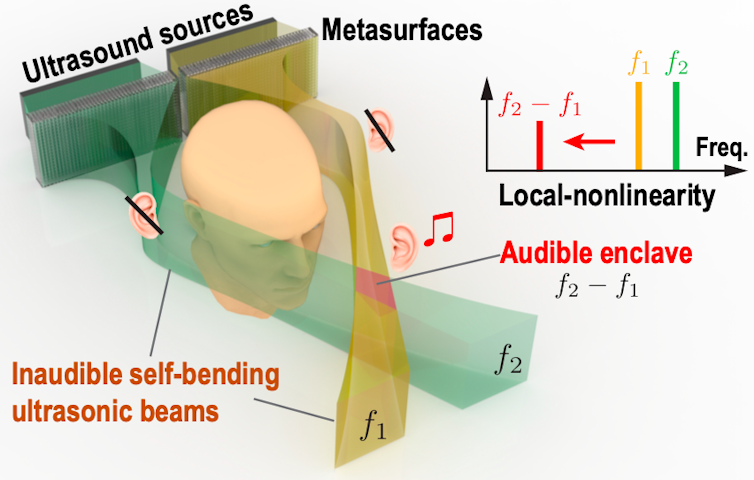Or have a private conversation in public without other people hearing you?
In other words, weve developed a technology that could create sound exactly where it needs to be.
What is sound?

Digital audio waveform.© Nazario/Shutterstock
Sound is a vibrationthat travels through air as a wave.
These waves are created when an object moves back and forth, compressing and decompressing air molecules.
The frequency of these vibrations is what determines pitch.

Sound is composed of particles moving in a continuous wave.
Certain audio technologies, such asparametric array loudspeakers, can createfocused sound beamsaimed in a specific direction.
Ultrasound refers to sound waves with frequencies above the human hearing range, or above 20 kHz.
These waves travel through the air like normal sound waves but are inaudible to people.

Audible enclaves are created at the intersection of two ultrasound beams.
In our work, we used ultrasound as a carrier for audible sound.
It can transport sound through space silently becoming audible only when desired.
How did we do this?

Normally, sound wavescombine linearly, meaning they just proportionally add up into a bigger wave.
Crucially, we designed ultrasonic beams that can bend on their own.
Normally, sound waves travel in straight lines unless something blocks or reflects them.

The key phenomenon at play is whats calleddifference frequency generation.
Sound can be heard only where the beams cross.
Outside of that intersection, the ultrasound waves remain silent.

Advancing sound control
The ability to create audio enclaves has many potential applications.
Audio enclaves could enable personalized audio in public spaces.
In a car, passengers could listen to music without distracting the driver from hearing navigation instructions.

Offices and military parameters could also benefit from localized speech zones for confidential conversations.
This isnt something thats going to be on the shelf in the immediate future.
For instance, challenges remain for our technology.

Nonlinear distortion can affect sound quality.
Despite these hurdles, audio enclaves present a fundamental shift in sound control.
Jiaxin Zhong, Postdoctoral Researcher in Acoustics,Penn StateandYun Jing, Professor of Acoustics,Penn State.

This article is republished fromThe Conversationunder a Creative Commons license.
News from the future, delivered to your present.










